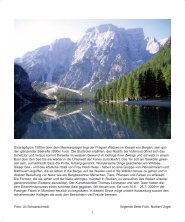Tobique First Nation, NB August 2010 - Schaarschmidt IT
Tobique First Nation, NB August 2010 - Schaarschmidt IT
Tobique First Nation, NB August 2010 - Schaarschmidt IT
Create successful ePaper yourself
Turn your PDF publications into a flip-book with our unique Google optimized e-Paper software.
<strong>Tobique</strong> <strong>First</strong> <strong>Nation</strong>, <strong>NB</strong> <strong>August</strong> <strong>2010</strong><br />
Wulustuk Times<br />
Wulustuk - Indigenous name for St John River<br />
This publication produced monthly at <strong>Tobique</strong>, <strong>NB</strong>, Canada E7H 5K3<br />
Wulustuk Times:<br />
Each month we gather and publish the latest, most current and relevant native<br />
information for our readers. Proceeding with this concept, we feel that a well informed<br />
person is better able to see, relate with, and assess a situation more accurately when<br />
equipped with the right tools. Our aim is to provide the precise tools and the best<br />
information possible.<br />
Contact:<br />
We can be reached at Box 3226, Perth-Andover, <strong>NB</strong>. Canada, E7H 5K3, or at Box 603,<br />
Ft. Fairfield, ME 04742. By phone we’re at 506-273-6737 (<strong>NB</strong>. Canada), and on the net,<br />
check us out us at - pesun@nbnet.nb.ca
TABLE OF CONTENTS - AUGUST <strong>2010</strong><br />
Wolastoqiyik GROUNDNUT- NO OTHER LIKE <strong>IT</strong><br />
RE-DEVELOP MT CARLETON PARK? -TOBIQUE GROUP, A B<strong>IT</strong> HES<strong>IT</strong>ANT<br />
<strong>NB</strong> FIRST NATION HOPEFUL OF DAM’S REMOVAL<br />
SEPARATE MARKET FOR SMALL SCALE HYDROELECTRIC PROJECTS FOR<br />
FIRST NATIONS<br />
THIS LAND IS STOLEN<br />
DAN’S CORNER--- TRAD<strong>IT</strong>IONAL LEADERS<br />
DEAN’S DEN -- SPIR<strong>IT</strong> CANOE<br />
TALKING CIRCLE at Woodstock, SATURDAY, SEPT. 11<br />
-(12 NOON)<br />
Wolastoqiyik GROUNDNUT- NO OTHER LIKE <strong>IT</strong><br />
".... Father Biard, with the servant and another who had joined them, named Jean<br />
Baptiste Charpentier, first made a trip up the river. They went in search of acorns and<br />
roots. These roots in the Savage language are called Chiquebi, and grow readily near<br />
oak trees. They are like truffles, but better, and grow under the ground strung to each<br />
other like a rosary. There are many of them in certain places, yet it is very difficult to find<br />
any place where the Savages have not already been digging, and thus only very small<br />
ones are to be found. Also we must work hard to get enough of them for a day's food."<br />
(Father Biard's relation in the Jesuit Relations, Volume III, 1616.)<br />
By the time you are reading this in <strong>August</strong> the groundnut plants, Apios americana, will<br />
be starting to develop their most unusual blossoms of light pink, lavender, and rosybrown<br />
clusters along their twining vines. By mid to late <strong>August</strong> the blooms will be seen<br />
climbing over small bushes, fallen trees, and other objects or plants like strings of patio<br />
lights.<br />
The groundnut plant, or Indian potato (as influenced by the English), is called<br />
"ktahkitom" or "tahkitom" by the Wolastoqiyik, or "skicinuwi-pocetes" for Indian potato.<br />
The term Indian Potato can be confusing since it is also used for the Sunchoke<br />
(Jerusalem Artichoke) tubers in some older publications. In journals of the early white<br />
explorers and also the captives of the French–Indian wars, the groundnut is often<br />
referred to because it was a common food staple of the Wabanaki nations. Champlain<br />
recorded it in his journals and drew a detailed picture of it in his 1612 Map. He labelled<br />
it "pisque penay." Remnants of groundnut tubers have been found in archaeological<br />
digs of Native American campsites in southern New England that date back 9,000 years.
It is a climbing vine related to the pea family, and it is a distant relative of the soybean.<br />
Similar to other legumes it has nitrogen fixing properties, which is beneficial when grown<br />
with other nitrogen hungry vegetables like corn and squash. The roots also grow in long<br />
strings like the vines that are above ground. Tubers grow along the root strings much<br />
like beads in a necklace. The larger and more nourished the vine, the larger the tubers<br />
will grow. They can be as small as a jellybean or as large as a lemon. These tubers are<br />
where the plant gets its English names of groundnut and Indian Potato. Like potatoes,<br />
they can be peeled and are white with a firm flesh inside. Their flavour is mild like a<br />
potato too. They can be eaten fresh, boiled, baked like the potato, or added to soups<br />
and stews. But they are even better for you than potatoes, having three times the<br />
protein. The tubers also contain estrogenic isoflavones (phytoestrogens) such as<br />
genistein, which has anticancer properties. This is accomplished by preventing the<br />
formation of blood vessels that nourish new tumours.<br />
Now comes the most interesting part. The groundnut of the Wolastoqiyik is unique to<br />
their people and territory. There is no other like it. It produces flowers, but it does not<br />
produce the tiny pods full of seeds after the flowers drop. It cannot reproduce by seed<br />
like its more southern relatives in the New England states. It can only reproduce by the<br />
tubers. Therefore all plants from this variety are clones, and none of the clones can<br />
reproduce by seed either.<br />
In 1973 Dr. Jane Seabrook did a study of this plant for writing a Master's thesis at the<br />
University of New Brunswick (Study of the Genus Apios. 1973. Janet E.A. Seabrook),<br />
and subsequently she published an article in the Canadian Journal of Botany (Seabrook,<br />
Janet E.A. 1976. Studies on the genus Apios. I. Chromosome number and distribution of<br />
Apios americana and A. priceana. Can. J. Bot. V. 54. No. 22). In her own words Dr.<br />
Seabrook writes, "I think we established a good case for the species being out of its<br />
normal geographic range because of transport by Native Peoples. As far as we could<br />
tell, there seemed to be only one clone in Eastern Canada, and all plant material in<br />
Eastern Canada that we sampled were triploid (three rather than the normal two sets of<br />
chromosomes). This would explain why there were no seed pods because triploid<br />
plants are nearly always sterile. Furthermore, triploid plants are common at the northern<br />
and southern ranges of many native plants." The she adds this interesting note, "We<br />
always found Apios americana plants growing near or downstream from either Native<br />
Peoples portage sites or reservations. If you look at Hal Hinds’ Flora of New Brunswick,<br />
it is quite remarkable that the distribution of Apios americana follows waterways or<br />
coastal areas."<br />
So this nutritious plant was primarily spread throughout Wolastoq land by the ancestors<br />
who carried them on hunting trips and on other journeys, stopping at the end of a<br />
portage to rest and munch on a few of these little round tubers. I have wandered along<br />
the historic locations of Wolastoqiyik encampments along the river and in the islands<br />
and found these plants. In these same locations are almost always the sunchokes,<br />
beach plums, and butternut trees, all common foods gathered and stored by the<br />
Wolastoqiyik to help them through the hard times of the season when food was most<br />
scarce. How many of today's younger generation walk right past these nutritious and<br />
free foods that helped their ancestors survive?
Like the fiddlehead (mahsus), the groundnut is specifically associated with the<br />
Wolastoqiyik culture, but since it requires more effort to dig the roots up in search of the<br />
tubers, it seems to have disappeared from the list of foods still eaten today. The plants<br />
are easy to propagate by the tubers, so it would require very little effort to have a patch<br />
growing in a garden spot near the house, or a common garden in the community.<br />
This is just one of many food and medicinal plants used by the ancestors, and they<br />
taught the first white settlers about them, who soon realized their value. Perhaps it is<br />
time to revive these lost foods and medicines and develop some traditional gardens in<br />
Wolastoqiyik land to preserve and to teach the young generation that all foods and<br />
medicines don't have to come from a supermarket or pharmacy.<br />
............. all my relations, Nugeekadoonkut<br />
RE-DEVELOP MT. CARLETON PARK? -TOBIQUE GROUP A B<strong>IT</strong> HES<strong>IT</strong>ANT<br />
p.paul<br />
TOBIQUE FN - Alain Basque, Director, Tourism Operations, Province of New Brunswick<br />
met with several community members of <strong>Tobique</strong> <strong>First</strong> <strong>Nation</strong> on Friday, July 16 to<br />
discuss and seek community input on upgrading and developing new plans for Mt.<br />
Carleton Park.<br />
According to the Director, the present plans developed in the late 1970's and early 80's,<br />
and the last set in 1998 are considered somewhat out-of-date and hardly representative<br />
for transitions taking place in park services today.<br />
The Department of Tourism is therefore making room and directing new monies to<br />
upscale many features within the three major parks in the province.<br />
To accomplish a reasonable and an acceptable plans for redevelopment, Tourism<br />
representatives recently held community meetings in Campbellton, St, Quinten and<br />
<strong>Tobique</strong> FN to listen to peoples concerns and opinions on new ways to successfully run<br />
and operate public provincial parks across the province.<br />
In northern New Brunswick, the focus was mainly on two parks, Sugarloaf and Mt.<br />
Carleton.<br />
Both Sugarloaf near Campbellton, and Mt. Carleton located in the upper reaches of<br />
<strong>Tobique</strong> River, east of St. Quinten, received fairly good ratings and satisfactory reviews<br />
from government officials as well as from the local people in those northern areas.<br />
At <strong>Tobique</strong> however, with <strong>First</strong> <strong>Nation</strong>s attending, Director Basque introduced the 2-hour<br />
meeting with an overview of Mt. Carleton’s history and operations since it opened in the<br />
1960's.<br />
After the introduction the meeting proceeded well with all participants offering thoughts,<br />
views and opinions, but expressed some concerns about the lack of consultation and<br />
communication with Wulustukieg on park issues over the years.
SOME OF THE ISSUES RAISED:<br />
It was noted at the start of discussions that the matter of re-planning or re-developing<br />
Mt. Carleton Park should be temporarily abated until such time that native (Wulustukieg)<br />
issues and concerns have been satisfactorily dealt with or resolved.<br />
One glaring misstep on the part of the Tourism officials that prevailed from the start and<br />
right to this day was the lack of consultation and involvement given to native people in<br />
every phase of the park’s operations.<br />
For instance a huge mistake was the lack of recognition accorded to first nations on the<br />
stone monument placed atop the mountain. The inscription ignores the mountain’s<br />
sacred value as a revered spiritual place where Wulustukieg gathered year after year for<br />
centuries to honour, pray and give thanks to the spiritual elements abound and for<br />
medicines provided by the mountain to Wulustukieg for many centuries.<br />
The <strong>Tobique</strong> group stated that the wildlife in the park as well as in the province has been<br />
put under severe strain or a definite risk of extinction. The strain comes from human<br />
activities in tearing up and clear-cutting of woodlands from end to end. The group<br />
maintained that when the forests are cut away to the last tree the animals are forced to<br />
go without a home, a shelter or food supply. This denial of survival basics to wildlife can<br />
lead to exposure, starvation and termination.<br />
Just recently the media reported that the American marten has gone extinct in <strong>NB</strong> due to<br />
man’s intrusion into the wilds. Also earlier, around the late 1960's, the Whippoorwill,<br />
heard almost everywhere back in those times, has also disappeared. And yet another<br />
species faded from the scene since the 1900's, is the Caribou whose trails and feeding<br />
areas could still be seen in certain areas.<br />
Many more species not yet defined or determined have also gone extinct due to man’s<br />
overuse and penetration into the woodlands. Sad to say that this oversight may extend<br />
even to the care-taking and management of our park systems.<br />
It was also explicitly stated to Director Basque that the original name of Mt. Carleton<br />
Area was Saugumaug at one time, (meaning ‘Chiefs’ -referring to the two peaks on the<br />
mountain top), instead of Mt. Carleton. Carleton was a name of a non-native government<br />
official in Lower Canada during the early colonial period who had no official capacity, ties<br />
or jurisdiction over Wulustukieg or their territories. So the aboriginal name should rightly<br />
be restored.<br />
Still another issue raised by the <strong>Tobique</strong> group was the clear cutting that went on in the<br />
park and the cut-away section is still visible to this day. This violation was committed<br />
likely by some reckless scoundrels who got away scot-free and never were caught or<br />
convicted by proper authorities despite the abundance of signage and warnings posted<br />
that no cutting is allowed on park grounds.<br />
Director Basque admitted that he was not aware of this particular clear-cutting incident<br />
but will look into it immediately and report his findings publically in due time.
Upon the discussion of clear cutting in protected areas, another question was posed<br />
regarding the quality of policing available in protected areas and park lands. Bluntly<br />
asked, -“Is there adequate policing and protection in the park to prevent a repeat of such<br />
a cruel incident?” Answer, “Not sure, but this too will be on the ‘check list,’ and will be<br />
dealt with properly”<br />
The <strong>Tobique</strong> delegation made it clear that the land entailing Mt. Carleton Park still legally<br />
belongs to native people based on the fact that all <strong>NB</strong> land, including park lands, were<br />
never ceded, sold, surrendered, given up, traded, treated, lost in battle or subject to any<br />
means of land disposal, conquest, or transfer.<br />
In summary therefore, native people who have continued to use and occupy this land for<br />
many centuries are of the firm belief that the Mt. Carleton area, including all New<br />
Brunswick is legally still Indian land, and not Crown Land as so popularly held and<br />
believed by governments.<br />
The aboriginal tenet that this land is still Indian Land will remain in the hearts and minds<br />
of Wulustukieg people forever.<br />
<strong>NB</strong> FIRST NATION HOPEFUL OF DAM’S REMOVAL<br />
Northern N.B. dam will be completely removed in 2011<br />
CBC News<br />
Onlookers watch the Eel River Dam's gates being opened in northern New Brunswick on<br />
Tuesday. (Allison Northcott/CBC) Hundreds of people turned out to watch the opening of<br />
the Eel River Dam on Tuesday, a step that many in the northern New Brunswick <strong>First</strong><br />
<strong>Nation</strong> believe is the first step to rehabilitating their local river.<br />
The dam has stood at the mouth of the river for the last 47 years and when the gates<br />
opened, the rush of water was greeted by a traditional Mi'kmaq song.<br />
For many people living on the Eel River Bar <strong>First</strong> <strong>Nation</strong>, such as Jenny Peter Paul,<br />
there is hope the dam's removal will turn around the fortunes of the region's ailing<br />
seafood industry.<br />
"They've been promising us all these years that the dam wasn't going to affect the<br />
fishing and clam beds and all that stuff, which it did," Paul said.<br />
Paul was 11 years old when the dam was built and she said she remembers life before<br />
it, when the river flowed freely.<br />
"Hopefully everything will go back to normal, like how it used to be. We used to make a<br />
good living through this before," she said.<br />
'It was a major assault on our community, on the environment. It took away some of the<br />
gifts that the creator has given our people.'— Gordon Labillois, band councillor<br />
The opening of the gates was stage two of the process to open up the northern river.
Along with opening the gates, this stage includes shoreline protection, the construction<br />
of a temporary vehicle deck and the excavation of a 150-metre-wide opening of the<br />
northern portion of the dam.<br />
The dam will be completely removed in 2011. Once the dam is cleared out, an extended<br />
environmental monitoring program will be commenced. The New Brunswick government<br />
estimates the project will cost $5 million.<br />
The New Brunswick government has stated its objective in the dam's removal is to<br />
improve fish passage, restore the habitat for soft-shelled clams and other shellfish in the<br />
region and create conditions that will allow for the re-establishment of salt marsh<br />
wetlands upstream of the dam.<br />
This is the second dam that has been partially opened in New Brunswick this year. In<br />
April, the causeway gates were lifted on the Petitcodiac River in Moncton.<br />
Built in 1963<br />
Gordon Labillois, a <strong>First</strong> <strong>Nation</strong>s band councillor, said the town of Dalhousie's decision<br />
to construct the dam in 1963 was a major assault on the environment. For generations,<br />
people in Eel River Bar used the river to fish for eel and smelts and dig for clams.<br />
But that changed in 1963 when the dam was built by the town of Dalhousie as an<br />
industrial water source for industries.<br />
Jude Caplin, who lives in Eel River Bar, said many people in the <strong>First</strong> <strong>Nation</strong> lost a part<br />
of their heritage when the river was dammed by Dalhousie.<br />
"Our elders tell us that that was their main work, it was the babysitter, it was the town<br />
newspaper, it was everything," Caplin said.<br />
"And now, without the clam beds, you got to go to Tim Hortons to get all the news now."<br />
Many in the area feel strongly about the negative impact that the dam had on the<br />
traditional way of life for <strong>First</strong> <strong>Nation</strong>s.<br />
Gordon Labillois, a band councillor, said the community lost something when the dam<br />
was built.<br />
"It was a major assault on our community, on the environment. It took away some of the<br />
gifts that the creator has given our people," Labillois said.<br />
Labillois said he has been working to have the dam removed for 20 years.<br />
He said it is important to recognize what his community lost when the river was blocked.<br />
"This took away six months of economic resources, of harvesting resources, out of the<br />
river, and bigger than that, the loss of a way of life, it's a way of life that our people had,"<br />
he said.<br />
The river's restoration is expected to take at least a decade. But Labillois said he is<br />
confident the river will return to the vital waterway it once was.
SEPARATE MARKET FOR SMALL SCALE HYDROELECTRIC PROJECTS FOR<br />
FIRST NATIONS<br />
WENDAKE, QC, July 5 /CNW Telbec/ - The Assembly of the <strong>First</strong> <strong>Nation</strong>s of Quebec<br />
and Labrador (AFNQL) is delighted for those communities whose projects were<br />
approved by Hydro-Québec as part of the Program to purchase power from small<br />
hydroelectric generating stations of 50 MW, following the company's announcement last<br />
Wednesday. Of the 13 projects approved, six (6) were submitted by <strong>First</strong> <strong>Nation</strong>s<br />
communities.<br />
The Aboriginal projects approved involve three Innu communities and one Atikamekw<br />
communitiy. Two projects were proposed by the Innu Council of Pessamit and will be<br />
carried out on the Sault-aux-Cochons River. The Montagnais Council of Lac-Saint-Jean<br />
(Mashteuiatsh) also submitted two projects, one on the Ouiatchouan River, the other on<br />
the Mistissini. The Innu community of Ekuanitshit will benefit from a mini-station go up<br />
on the Sheldrake River, while the Atikamekw limited partnership Manouane Sipi will<br />
harness the Manouane River.<br />
Still, a number of projects submitted by the <strong>First</strong> <strong>Nation</strong>s were not approved as part of<br />
this call for tenders addressed to Aboriginal municipalities and communities. "We must<br />
go a step further," says the Chief of the AFNQL, Ghislain Picard. "Given our rights over<br />
these territories and the quality of the projects proposed by many <strong>First</strong> <strong>Nation</strong>s, we urge<br />
Hydro-Québec to create a power purchase market reserved exclusively to the <strong>First</strong><br />
<strong>Nation</strong>s. This would not only benefit our communities, but the entire province."<br />
The energy production potential of the <strong>First</strong> <strong>Nation</strong>s territories is enormous, as is the<br />
creative and innovative potential of Aboriginal communities. This is why we urge Hydro-<br />
Québec to set up a tender market for hydroelectric and other projects that is reserved<br />
exclusively to the <strong>First</strong> <strong>Nation</strong>s, the keepers of these territories since times immemorial.<br />
"The communities need projects like this in order to achieve responsible social and<br />
spatial development that meets the needs of local populations," says Chief Picard.<br />
About the AFNQL:<br />
The AFNQL is a regional organization that brings together the 43 Chiefs of the <strong>First</strong><br />
<strong>Nation</strong>s of Quebec and Labrador. For more information, visit www.apnql-afnql.com.<br />
For further information: Éric Cardinal, Communications Consultant, 514 258-2315 (cell),<br />
eric@cardinalcommunication.com
THIS LAND IS STOLEN<br />
TORONTO—"I'm here on a personal matter," Jasmine Thomas of the Carrier <strong>Nation</strong><br />
tells a crowd of several hundred. "I live in Saik'uz, right in the heart of BC, a community<br />
of about 600. It's along the proposed Enbridge pipeline route... The proposed pipeline is<br />
threatening the traditional medicines that my great-grandmother has preserved for me."<br />
"Not only that," she continues, "I have family at ground zero, at the tar sands. So where<br />
my father used to hunt and fish and gather, there are now open pit mines that you can<br />
see from space.<br />
"The world's largest energy project is destroying my peoples."<br />
As the tear gas clears over Toronto and the corporate media's frenzy over broken<br />
windows subsides, little has changed for <strong>First</strong> <strong>Nation</strong>s people.<br />
Canada still has not signed the UN Declaration on the Rights of Indigenous People; 584<br />
Aboriginal women are still missing and murdered; and many of us still live on non-ceded<br />
<strong>First</strong> <strong>Nation</strong>s territory—and are exploiting it. The list could go on.<br />
On the other hand, Indigenous resistance is growing in Canada; so too are solidarity<br />
movements.<br />
For the second time in <strong>2010</strong> (the first being the Vancouver Olympics), <strong>First</strong> <strong>Nation</strong>s<br />
rights were at the forefront of a major convergence of social justice activists.<br />
"No G20 on stolen Native land," chanted demonstrators throughout the week of protests<br />
leading up to G8/G20 meetings, and warrior flags were flying at all the marches—<br />
whether led by environmental justice advocates or anti-poverty organizers.<br />
And on June 24, more than 1,000 people flooded the streets of downtown Toronto for<br />
the "Canada Can't Hide Genocide" march and rally.<br />
The crowd did not gather on June 24 to protest the G20 so much as to reject it entirely.<br />
"Fundamentally, we reject the G8 and G20 as decision-making bodies over our<br />
peoples," Ben Powless, a Mohawk from Six <strong>Nation</strong>s, told a cheering crowd. "These are<br />
the illegitimate organizations of the colonial states that seek the further exploitation of<br />
our peoples."<br />
Marilyn Poucachiche, an Algonquin from Barriere Lake <strong>First</strong> <strong>Nation</strong>, drove nine hours<br />
from her community to attend the rally and knows that story well.<br />
"The government has been trying to assimilate or has been assimilating [our] people for<br />
a long time," she says.<br />
Barriere Lake <strong>First</strong> <strong>Nation</strong> has a traditional governing system, a system that the Indian<br />
Act does not recognize. "The Canadian government have been trying to impose Section
74 in our community from the Indian Act," says Poucachiche. Section 74 would require<br />
the community to hold band elections. "It favours the Canadian policy on how we should<br />
govern and select our leaders."<br />
"That will extinguish our Aboriginal title and treaty rights," she says. "They're trying to<br />
select their Chief according to their law. But we're saying it's our way, not your way."<br />
Lionel Lepine, an Athabasca Chipewyan <strong>First</strong> <strong>Nation</strong>, says the Canadian "way" looks a<br />
lot like cultural genocide. Lapine lives at what he calls "ground zero," or Fort Chipewyan,<br />
upstream of the Alberta tar sands.<br />
"We are on top of the second largest deposit of oil in the world and they want every<br />
single drop at the cost of our lives," he says.<br />
“We're seeing environmental impacts, cultural impacts, human impacts; we're seeing<br />
death,” says Lapine. “We're seeing the death of the delta, water, animals, plants, air. It's<br />
just a matter of time before everything's going to be completely wiped out."<br />
Considering the devastation of his community and the planet, Lapine laughs at the<br />
police lining the march on all sides. "We are not the threat," he says. "The threat to this<br />
country are the people in power."<br />
But the growing Indigenous resistance is a threat to something, says Thomas: It's a<br />
threat to the pocketbooks of big business.<br />
"Canada, the US and Australia are avoiding signing the UN Declaration on the Rights of<br />
Indigenous people," she says. "One of the main points in that declaration is free, prior<br />
and informed consent. That means they have to respect our ability to say yes or no to<br />
development in our territories. So it's threatening their prosperity."<br />
The prosperity of a few is coming at a serious cost, says Thomas. "We are facing food<br />
security issues, basic human rights issues; we have the highest rates of cancer, HIV<br />
aids—all these socio-economic issues that are associated with these large projects<br />
[such as the tar sands]."<br />
Their connection to the land and also the fact that Indigenous people are literally fighting<br />
for their lives make their resistance powerful. "There's always been Indigenous people<br />
leading the struggle in terms of defending the land against these large corporations,"<br />
says Arthur Manuel from the group Defenders of the Land, a network of Indigenous<br />
communities united in defense of their lands, Indigenous rights, and Mother Earth.<br />
"Through supporting Indigenous People you're putting in place a new system of order<br />
that's based upon a more circular basis of economy, instead of the vertical economy that<br />
the system is working on...where the land isn't looked on as Mother Earth but everything<br />
is looked at as a resource base," says Manuel. "Indigenous People do not look at it from<br />
that perspective. [We] look at the Earth as part of the decision making process. We<br />
know that what we do to the planet will sooner or later impact on us."
Whether or not Canadians choose to support Indigenous struggles, the state, as<br />
Powless points out, has certain obligations.<br />
"Fundamentally," says Powless, "Canada must live up to its international and domestic<br />
treaty obligations and respect self-determination, the right for free, prior and informed<br />
consent and the sovereignty of our peoples."<br />
DAN’S CORNER- TRAD<strong>IT</strong>IONAL LEADERS<br />
Prior to contact with Europeans, Native Government in Turtle Island worked for the<br />
people, and the leaders in the communities assumed roles that they were born to fulfil. It<br />
was a natural flow that kept the communities in balance and harmony.<br />
While very young (sometimes from the moment of birth) leaders were recognized by<br />
members of the family or clan. Children, who were recognized for special talents or gifts,<br />
or who appeared to have some strong positive trait were often acknowledged by the<br />
community as a "future leader." Those children would be nurtured and taught in ways<br />
that would strengthen their leadership qualities. Teachings on the sacredness of Great<br />
Creator’s creation as well as walking the spiritual path on a moment by moment basis.<br />
Potential leaders could come from any member of the community, any family member or<br />
clan member, and usually the process took place naturally with no need for the<br />
community to decide who the next leader should be. In the instances when a leader<br />
needed to be chosen in the community, the responsibility fell on the women of the<br />
community. The grandmothers, the clan mothers, the Lifegivers - they did the choosing.<br />
At that time, our people knew that the women, by virtue of their special powers as the<br />
Lifegivers, knew and understood the community, its members and the needs of the<br />
community best. That is why they could be counted upon to make the decisions about<br />
leadership that would best benefit the whole community.<br />
At that time, before contact, we were taught the value of the spiritual life. Material and<br />
manmade things were of little value except in helping us in our day-to-day tasks. We<br />
were taught that Creator put us on this earthwalk for two reasons: to grow and develop<br />
from our experiences, and to be of service to others.<br />
We were taught that all of life is a ceremony, a ceremony of thankfulness and<br />
thanksgiving for life–all life–and the many gifts that Creator provides to us during our<br />
brief earthwalk. Under these kinds of spiritual laws, it was quite natural to nurture those<br />
who already demonstrated characteristics of leadership in their communities. Those who<br />
felt the call to lead in any particular area did so without question. They assumed the role<br />
for which they were needed in the community and when it was time for another to take<br />
their place or for them to move on to some other area, they did so with the knowledge<br />
that they were fulfilling the purpose and responsibilities for their life that had been given<br />
through the original instructions of Creator.<br />
There was no need to convince family members, clan members, or any community
member that a particular person, whether they be female or male, should be leader.<br />
Leaders had a spiritual path to follow, a vision, and a commitment to The Ancestors, The<br />
People and to The Seventh Generation. They also knew of this responsibility and<br />
accountability to The Ancestors, The People and to The Seventh Generation.<br />
It was never about self-gratification or self-interest. It had nothing to do with the<br />
accumulation of material wealth. And there was no such thing as campaigning! The most<br />
important consideration for any leader was the community. What was good for the<br />
community as a whole? What was good for The Ancestors, what was good for The<br />
People and what was good for The Seventh Generation?<br />
We see so little of this today in our communities. No wonder our communities are<br />
experiencing so many problems. We have leaders "elected" through a corrupt system<br />
that is so far removed from those original instructions given to us by Creator that they<br />
cannot be effective. There are few reminders of the true leaders in our communities.<br />
Those who emerge for a short time or for specific issues and offer strong accountable,<br />
traditional leadership are soon consumed by their own people.<br />
Instead, people with the small, petty minds who rule with self-interest use the democratic<br />
election system — the Indian Act system. The driving force behind this system of<br />
selecting leaders is money, lies, corruption and power. The consideration is not what we<br />
will benefit the community as a whole, but rather, what will benefit me and my<br />
supporters. It has no resemblance to the original instructions.<br />
Leadership today is predominantly male. We forget the Lifegivers. There is no<br />
acknowledgment of the teachings of the Ancestors. There is no thought about how<br />
decisions will affect the Seventh Generation. What is the legacy for our young people,<br />
our future leaders?<br />
There is a great price to pay for forgetting those original instructions that were given by<br />
Creator, by adopting a corrupt system that cares little about the people it is supposed to<br />
serve. That price is taking a toll on our communities.<br />
If we are to survive as a people, if we want to be truly accountable to our children and<br />
the generations yet to come, we must return to the traditional teachings of our<br />
Ancestors. If we do not, we will continue to experience all the social, family, community<br />
and individual unrest, violence, disorder, and finally, extinction, that comes from this<br />
system our eurocanadian brothers brought and forced upon our people.<br />
Our Earth Mother will never be able to heal until things change. Once we return to the<br />
traditional teachings and ways of doing things, once we allow those leaders who are<br />
called for the good of our communities to lead us, once we return to those original<br />
instructions carried by our Ancestors for thousands of years, then things will change. We<br />
will find harmony and balance. We will find peace and unity. We will once again be that<br />
strong, spiritual, sovereign people that thrived for thousands of years prior to contact.<br />
And we will be able to pass on those original instructions so that our future generations<br />
will survive also. These are the teachings we need to pass on to our future leaders.<br />
All My Relation, Dan Ennis, <strong>August</strong> 1, <strong>2010</strong>
DEAN’S DEN - SPIR<strong>IT</strong> CANOE<br />
Into the stillness of the shadows<br />
Stole a striking silhouette<br />
Smoothly skirting shoal and sandbar<br />
Sees the challenge - hears - and yet<br />
Surging, coursing, undulating<br />
Crushing, crashing, in conflux<br />
Rapids, cataract, and torrent<br />
Boulders bruise and spillage sucks,<br />
Spectral phantom of the gorge<br />
Shrouded spirit, wandering soul<br />
Nobody ever ran The Narrows<br />
Plunged the cut - and came out whole,<br />
Macabre, unreal, uncanny<br />
Startling, stunning, perhaps obsessed<br />
Cleave the cleft and ride the rift<br />
And my eyes, are sorely pressed,<br />
Who can it be - ethereal elder?<br />
Water wraith - come racing through?<br />
Pulsing presence - headlong charging<br />
Graceful ghost? Spirit canoe?<br />
I follow it on past the passage<br />
Then realize the worst of fears<br />
Before it can be touched or asked of<br />
It starts to fade ... and disappears!<br />
-D.C. Butterfield<br />
TALKING CIRCLE NEAR WOODSTOCK, SAT. SEPT. 11 -(Starts 12 NOON)<br />
Participants who wish to attend the September Talking Circle are advised to travel to the<br />
town of Woodstock and find the Grafton bridge that spans the St. John River.<br />
Cross the Grafton bridge, turn right on Rte. 105 and follow the posted b/w Circle signs<br />
for 2 kilometers to the intersect of Kilmarnock Road. Follow the the Circle signs on that<br />
road for about 9 Km and that will eventually lead to the Circle site at Ducks Unlimited<br />
location on Gibson Millstream. For anyone needing more information or clarification,<br />
call Pat at 506-273-6737 or go to this link on the Internet: http://wiwoni.com/circle/
Quote from Chief Tecumseh - Shawnee (1768-1813)<br />
No tribe has the right to sell, even to each other, much less to strangers, ....Sell a<br />
country! Why not sell the air, the great sea, as well as the earth? Didn’t the Great Spirit<br />
make them all for the use of his children? The way, the only way to stop this evil is for<br />
the red man to unite in claiming a common and an equal right in the land, as it was first<br />
and should be now for it was never divided. We gave them forest-clad mountains and<br />
valleys full of game and for return what did they give to our warriors and our women?<br />
Rum, trinkets and a grave.<br />
Believe in yourself! Have faith in your abilities! Without a humble but reasonable<br />
confidence in your own powers you can be successful or be happy.


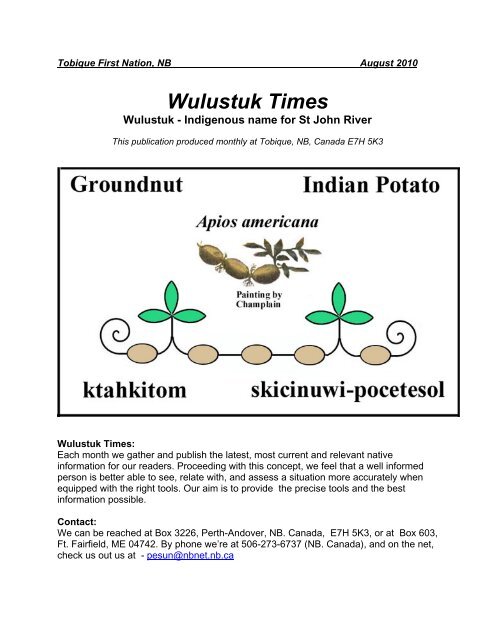

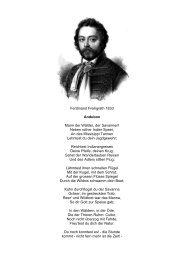
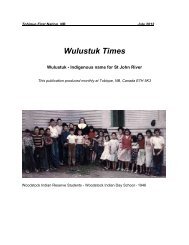
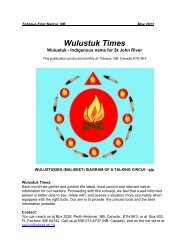
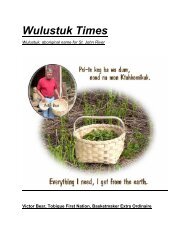
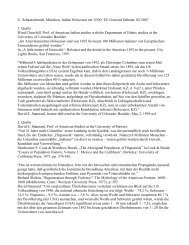
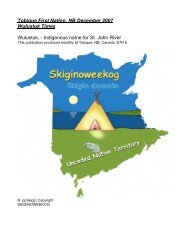


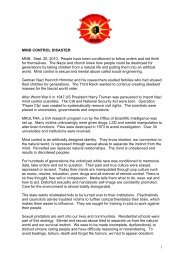

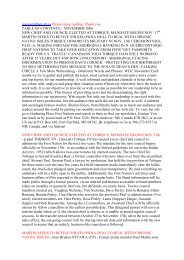
![WE HOLD THE ROCK [ALCATRAZ], SAID ... - Schaarschmidt IT](https://img.yumpu.com/22715400/1/184x260/we-hold-the-rock-alcatraz-said-schaarschmidt-it.jpg?quality=85)
